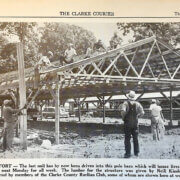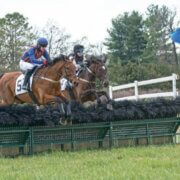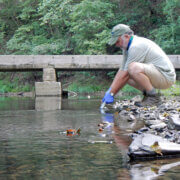A Small Piece Of Lead
Story and image by Doug Pifer
A young bald eagle, grounded and unable to stand up, was brought to Blue Ridge Wildlife Center in Boyce for treatment. Lab tests revealed high levels of lead in the bird’s blood, and unfortunately, this eagle did not survive.
Blue Ridge Wildlife Center treats many eagles each year. Most of them are victims of some kind of trauma — collisions with vehicles being the main suspect. However, the Center also finds that more and more rescued eagles show low levels of lead in their systems. The presence of lead, according to the Center, can slow an eagle’s reaction time, making it more prone to life-
threatening situations.
Subsequent tests revealed this young eagle had 27 micrograms of lead per deciliter in its blood. The normal amount of lead in a healthy animal’s blood is zero. And one lead fragment the size of a grain of rice is enough to kill an eagle.
How does lead enter an eagle’s body? Gut piles left in the woods by deer hunters are a major source. When a hunter shoots a deer, they remove the internal organs. Some hunters bury the offal but most people leave the gut pile in the woods, knowing that it will soon be cleaned up by animals. Since prehistory, hunters have done this, and it’s a great example of recycling.
Eagles, hawks, bobcats, raccoons, foxes — many animals people think of as predators — gather at gut piles. Even songbirds like chickadees appear when a hunter or another predator kills a deer. Everybody loves a free meal.
Years ago, I watched a fellow who hunted on the property where we lived shoot a deer in the middle of the field behind our house. He field dressed it on the spot before loading it into his truck. This happened late one December afternoon and it snowed overnight. Next morning, five or six turkey vultures stood around the gut pile. One picked at the entrails while others stood in the snow, neck feathers fluffed around their bare heads like hooded messengers of death. Through their midst walked several crows, seizing and fighting over bits of food.
As more vultures arrived, I set up my spotting scope at the window, got my sketchbook, and spent the morning watching various visitors come and go. By mid-afternoon the gut pile was gone and my sketchbook contained drawings of vultures, crows, a raven, a red-tailed hawk and a pair of red foxes. Later I wrote a story titled,
“Gut Pile Party.”
When a hunter shoots a deer, the soft lead bullet bursts into small fragments upon impact. Tests and x-rays show tiny pieces of lead that penetrate the flesh as far as 18 inches from the entry point. Even if the bullet pierces its heart or lungs, a deer is small enough that fragments can spread into internal fat, stomach and intestines, which when discarded are consumed by
scavenging animals.
If a fox, vulture, or eagle eats meat containing lead fragments, its stomach breaks down the lead and its blood carries it throughout the body, causing neurological problems and organ failure. According to Blue Ridge Wildlife Center, “While most hunters trim some distance from the entry wound, many don’t realize just how much meat has been contaminated, both for themselves when they consume this meat later, but also for the wildlife they leave to scavenge the gut piles.”
Solving the problem of lead poisoning in wildlife includes the use of non-toxic ammunition. Many state and federal wildlife management areas throughout the country have required waterfowl hunters to use non-toxic steel shot in their shotguns since the 1970s. Much research has gone into the manufacturing of non-toxic ammunition for big game animals, too. Several organizations have conducted ballistic studies and research on the use of copper bullets.
For more information and availability of non-lead ammunition, see huntingwithnonlead.org.
The Eyes And Voice of the Shenandoah River
Riverkeeper Mark Frondorf works for a cleaner river for everyone to enjoy
By David Lillard
A lot of people know their special spot along the Shenandoah River, whether they paddle it, farm it, or own it. Few people — maybe no one — knows the entire river and both its forks as well Mark Frondorf. A guide for over 20 years, and the Shenandoah Riverkeeper since 2015, Mark spends every day either on the water or fighting to protect it. His job is to defend the Shenandoah against pollution, protect the right to clean water, and promote the recreational use of this beautiful river.
In 2024, we at Clarke Monthly will publish regularly about the river and its place in our lives here in Clarke County. Mark took a short break from the busy legislative session to share his views about some of the big issues facing the Doah, as well as some good news on the horizon.
What’s the news from Richmond
“We’re looking at three or four water bills in particular,” said Mark. “They include PFAS, water quality standards, one involving wetland delineator certification.” Okay, that’s a mouthful. Let’s unpack.
SB 243 is a bill to create a PFAS advisory committee. PFAS are per- and polyfluoroalkyl substances. These widely used industrial substances are highly toxic and break down so slowly they are known as “forever chemicals.” According to the U.S. Environmental Protection Agency, PFAS are found in the blood of people and animals all over the world and are present at low levels in a variety of food products and in the environment. They are found in water, air, fish, and soil at locations across the nation and the globe. They are known carcinogens. And only now are they beginning to get the attention of the public and policymakers.
“We’re trying to get a handle on PFAS in Virginia by monitoring publicly owned source water and wastewater,” said Mark. That includes biosolids, the stuff that’s left after sewage processing. “We are inadvertently applying PFAS to our agricultural soil.”
HB 1472 would improve water quality standards. “This bill takes a strong look at Virginia water quality standards,” said Mark. He said there are instances where Virginia requirements don’t necessarily align with Clean Water Act thresholds for fishable, swimmable, drinkable rivers and streams. “A paper mill, for example, meets itsVirginia permit requirements, but negatively impacts fishable, swimmable, drinkable water,” he said. The Clean Water Act contains narrative standards as well as thresholds. The bill would require use of
narrative standards.
HB 1182 would weaken certification standards for wetland professionals. Traditionally, wetland delineators are trained wetland experts. Their job is to evaluate construction projects for potential damage to wetlands. This bill reduces the experience requirements and eliminates the requirement to take a course in the topic at all. “We could put a bunch of hacks out there approving any kind of project,” said Mark. “It’s bad legislation.”
Drought’s impact on groundwater
“The last few snowstorms and rains have helped, but we have a long way to go before we get our groundwater levels back to where they need to be,” Mark said. The groundwater well at Blandy Experimental Farm, he said, saw a drop of 12 feet from January to December 2023. “I’m concerned that if we have a repeat of 2023, come August or September, we’ll have even more wells running dry. Already, people are having to drill a new one, or dig their existing one deeper.” He said well drillers are backed up drilling new wells for existing wells.
“Shenandoah River water levels flatlined at the one-foot level on the Front Royal gauge from this past July through October. That’s all groundwater bubbling up.” Spout Run in Boyce, for example, comes out of the ground and emerges as a free running stream. That’s groundwater. The river is literally running on water from the ground, not the air.
Mark cited a study by World Resources Institute that predicts we will need 20 percent more water by 2030. “Where will it come from,” Mark asks.
Making matters worse for the Shenandoah are systems like the one serving Winchester. It pulls water out of the Shenandoah that is then discharged into the Opequon, which further reduces the river’s flow and contributes to harmful algae blooms.
Positive steps on algae
Last year saw the start of a $2.5 million algae-bloom study to look at blooms in the Shenandoah and at Lake Anna. The study is being managed by Virginia’s Department of Environmental Quality, and conducted by U.S. Geological Survey and Interstate Commission on the Potomac River Basin. “The first two years will focus on data collection,” said Mark. “Year three is analysis, findings, and recommendations.”
River advocates hope that the recommendations will include establishing clear standards for nutrients, a step that should lead to the Shenandoah being listed as an impaired stream. That, in turn, will require a watershed plan and open the door to potential funding for restorative projects. It would also end the bizarre irony that has plagued the Shenandoah and other Virginia rivers and streams: EPA couldn’t put the river on the impaired stream list, because Virginia doesn’t have numeric nutrient standards for what impairs a stream. The joke has always been: No standards,
no problem!
The guy in a boat
Mark Frondorf is a rare breed. For more than two decades, he led a double life: as a policy wonk in a think tank and a fishing guide with secrets and tales to tell. It’s a dual nature that still serves him well. Water policy is about science and law, about what is the stuff getting into the water and what it does to the things that live in it, the people who drink it and play in it. For their part, anglers know when something is off in
the river.
They also know that the only way to know a river and to love a river is to spend time on it. Sharing the river with people of all ages and backgrounds is the part Mark likes most. “We promote river access and recreation. We believe the best stewards of the river are the users of the river,” Mark says. “If you take your son or daughter out for a fishing trip or paddling trip, it becomes their river. It becomes their story.”
For countless people, Mark is part of that story, their introduction and their grounding on the Shenandoah, even if they don’t know his name. One time several years back I was standing by the river and spotted Mark paddling on the far side. “Yo Mark!” I called. “Mark!” It was a windy day and the water is wider there. “Yo Mark!”
Mark didn’t hear me, but the guy nearby turned to me and said, “So that’s his name. The guy in the boat. I fish all over this river, and I see that guy everywhere. Thought he might be following me or something. He’s everywhere. Mark.”
I told him about Mark, the Potomac Riverkeeper Network that houses three riverkeepers: Mark on the Shenandoah, Brent Walls on the Upper Potomac, and Dean Naujoks on the Potomac River. And about riverkeepers and waterkeepers in general. Full disclosure: I’ve been to a few River Rallies.
You can listen to Mark live on WZRV-FM and WFTR-AM on Mondays and Fridays at 8:40am and at 4:30pm (thereabouts) during the “recreation season” running from the end of March to the beginning of October. Mark calls it vegetables and dessert. “Mondays are the vegetables, or where I talk issues. Fridays are the dessert or fun stuff. Where we talk about fishing or paddling conditions or bird migration or Virginia bluebells or fun stuff to get out and enjoy the resource.”
I am looking forward to checking in with Mark, the guy in the boat, from time to time this year. And to other
Shenandoah stories.
Learn more about the Shenandoah and Mark at PotomacRiverkeeperNetwork.org.
Is Mediation Better For Your Heart? Evidence Says Yes
Law Matters By Brenda Waugh
February marks American Heart Month, a dedicated time to prioritize cardiovascular health. Amidst the advice on diet changes and exercise, the role of how legal conflicts impact our heart health might be overlooked. As a lawyer/mediator, I’ve observed that legal proceedings may be harmful to our health! They increase our underlying stress, make us feel out of control, often further destroy relationships, and tend to increase episodes of anger. All of these emotional responses can be destructive to our hearts, and the damage may persist long after the legal case is over.
A recent study at Johns Hopkins University followed a group of women and men over age 18, and found that those with
multiple divorces had a higher risk of a heart attack. When possible, alternative dispute resolution, such as mediation, can reduce some risks created by litigation. When we are working together to resolve a problem rather than attacking it as adversarial, the negative health impact may be mitigated. So, this month when you are working to clean up your diet and increase your exercise, consider selecting ADR over litigation when you have a legal problem.
Stress. Legal proceedings, particularly litigation, can be stress-inducing. Studies show a correlation between stress, including that generated by legal conflicts, and an increased risk of heart-related issues. Elevated cortisol levels that are released during stress can lead to higher risks of heart disease. Even short-term stress impacts blood flow and raises the risk of stroke. One study, known as Interheart, showed that psychological stress is a risk factor similar in heart-damaging effects to the more commonly measured cardiovascular risks.
In contrast, alternative dispute resolution (ADR) methods offer alternatives, such as mediation, arbitration, collaborative law, and restorative justice. The legal problem that gives rise to litigation certainly produces stress. However, the litigation process that tends to take a long time, comes accompanied by deadlines, complex procedures, and many factors that increase the stress in resolving the legal problem. ADR processes are often faster and simpler, and serve to empower individuals, reducing stress and promoting heart health.
Feeling a loss of control. Feeling out of control is inherent in court proceedings. Judges make decisions, lawyers know things that the parties don’t understand. Your body responds to feelings of loss of control by increasing the amount of stress hormones in your body, which increases the amount of inflammation in your body, which increases your heart rate and/or irregular heartbeats,
Strained relationships. Legal disputes often further strain relationships,
contributing to heart disease. ADR processes like restorative justice and transformative mediation prioritize repairing relationships and acknowledging the impact of healthy relationships on cardiovascular health. One form of strained
relationship, broken heart syndrome, is a sudden weakness in the heart muscle, that can result from emotionally stressful events.
Cardiologist Dr. Sandeep Jauhar, writing in the New York Times, claims that unhappy relationships (and work stress and poverty) influence heart disease. He cites studies that demonstrate that people who feel socially isolated or chronically stressed by work or relationships are more prone to heart attacks and strokes. www.nytimes.com/2018/10/30/well/live/how-emotions-can-affect-the-heart.html.
Anger. Litigation often fuels anger among litigants, further risking heart health. Anger during arguments or disputes can increase heart rates and long-term health problems. “Studies show there may be a link between patients with increased anger and a higher risk of developing premature coronary heart disease and suffering coronary events,” says Druenell Linton, M.D., a cardiologist at Piedmont. “The link is likely both direct, via damage of the vessel wall, and indirect, as these patients often have more risk factors like smoking, hypertension,
and hyperlipidemia.”
While parties in mediation or any ADR process may experience anger, the process is not adversarial and does not encourage parties to blame or make accusations against the other. This serves to minimize, rather than
increase anger.
American Heart Month serves as a reminder not only to focus on traditional aspects of heart health but also to consider the broader impact of our daily lives, including legal matters. As lawyers and mediators, we play a crucial role in shaping outcomes and mitigating stress for individuals involved in legal disputes. Understanding the link between stress, litigation, and heart health underscores the importance of alternative dispute resolution methods.
By considering mediation, arbitration, and other ADR processes to address our legal conflicts, we can contribute to reducing the emotional toll on individuals, fostering healthier relationships, and ultimately enhancing cardiovascular well-being.
Brenda Waugh is a lawyer/mediator with Waugh Law & Mediation, serving clients in the Blue Ridge region of Virginia and Eastern Panhandle of West Virginia.
Awareness, Prevention and Resource Fair Shows Community Help Is Available
By Rebecca Maynard
If you or someone you know is struggling with drug addiction or mental illness, help is available. On January 10, Clarke County Public Schools, in conjunction with the Clarke County Sheriff’s Office and the Northwestern Community Services Board, held an awareness, prevention, and resource fair at the school to let the community know where to turn when they need help.
Special Agent Thomas Hickey of the Drug Enforcement Administration spoke with a slideshow illustrating the dangers of Fentanyl, an opioid drug 50 times more powerful than heroin and 100 times more powerful than morphine, which continues to fuel an epidemic of drug overdose deaths in the
United States.
Since 2018, Fentanyl and its analogues have been responsible for most drug overdose deaths in the United States, causing over 71,238 deaths in 2021. It constitutes the majority of all drug overdose deaths in the United States since it overtook heroin in 2018 and has been reported in pill form, including pills mimicking pharmaceutical drugs such as oxycodone. Fentanyl’s ease of manufacture and high potency makes it easier to produce and smuggle, resulting in fentanyl replacing other abused narcotics and becoming more widely used.
“They [drug dealers] are mixing it with Adderall medication for ADHD, and college kids are taking it so they can stay up all night,” Hickey said. “It’s just crazy because you have no idea what is in those pills, and you have to believe that everything is laced with Fentanyl at this point.”
Although the statistics are grave, Hickey wants the community to know that help is available. The Northwestern Community Services Board, which serves several local counties including Clarke, offers intensive outpatient programs three times per week. Services include evidence-based individual and group counseling, medication management, and psychoeducation groups. American Society of Addiction Medicine approved curricula are utilized in the program.
Office-based opioid treatment is also available, as well as substance exposed infants program and a recovery skills group. Anyone having a mental health crisis is encouraged to call 540-635-4804. A variety of programs and assistance are available, including counseling, psychiatric rehabilitation day programs, and residential living for those discharged from psychiatric facilities.
The organization also offers prevention programs and has devices available such as lock boxes to control prescription medication use.
“It’s on the user to say, ‘I need help,’” Hickey said. “We can get you the help, but you need to want the help.”
“People can always reach out to the sheriff’s office,” said Chief Deputy Patricia Putnam of the Clarke County Sheriff’s Department. “If you know of someone or need help yourself, please reach out to whoever you’re most comfortable with and start a conversation so you can get help.”
For those concerned about calling the police or sheriff’s department on behalf of a loved one in mental health crisis, the Northwestern Community Services Board has provided crisis intervention training for more than 450 law enforcement officers.
“The training I received exceeded my expectations and has been very useful in my daily operations,” said Berryville Police Chief Neal White on the organization’s website. “Mental health issues have been gaining national attention and it is important to the mission of public safety to make an investment in training staff on how to respond to calls for service dealing with
the mentally ill.”
The Northwestern Community Services Board has a Clarke County clinic located at 309 W. Main St. in Berryville and can be reached at 540-277-8080 or www.nwcsb.com. The Clarke County Sheriff’s Office can be reached at 540-955-1234, and the Berryville Police Department is at 540-955-3863.









